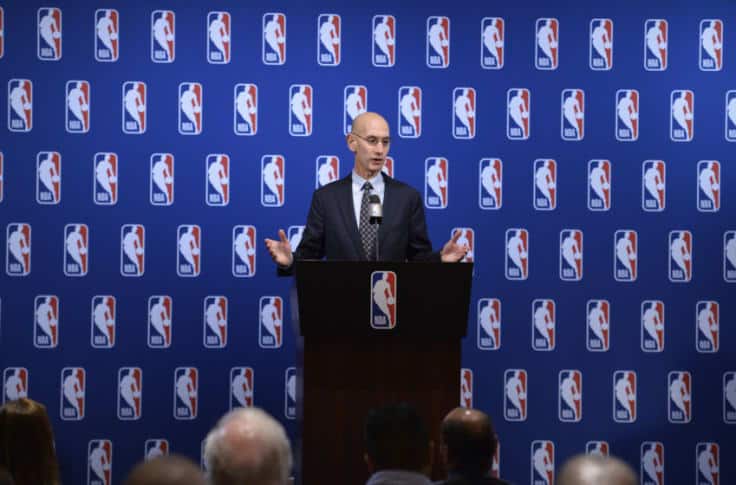The salary cap is the amount of money that NBA teams can spend on players’ salaries. It is designed to level the playing field and create a more competitive atmosphere inside the NBA. With a level playing field in terms of salary, it would mean that any team could win the NBA, not just the richest. How much can you go over the NBA salary cap?
How much can you go over the NBA Salary cap? Even though there is a salary cap in the NBA, teams can go over it, if they pay additional taxes. There are no limitations on how much they can step over the cap. While the owner of a team is required to pay from his pocket, generally they abstain from surpassing the limit.
The salary cap in the NBA is a very complex topic and has specific characteristics. In this article, we will overview this subject thoroughly in every aspect you might be interested in.
When was the salary cap introduced in the NBA?
The NBA salary cap was introduced in the mid-40s of the 20th century, but it was canceled after a season and was not applied until the 1984/85 season. At that time, the limit was $3.6 million. The salary cap exists to equalize teams with different economic opportunities and prevent rich clubs from acquiring all the best players. This would damage low-budget rosters, who are not able to purchase top players. As for the 2020/2021 season the salary cap was set at $109,140,000 and the luxury tax threshold at $132,627,000. Basically, a lot of teams exceeded the initial amount.

Hard cap vs soft cap – what is the difference?
Generally, when we are talking about salary caps there are 2 main types: hard and soft. Hard salary caps are prevalent in the NFL and the NHL. It means that in no circumstances the teams can surpass the specified amount. Soft cap in contrast can be exceeded as long as the NBA teams pay additional taxes. There is the case of no cap, where teams have no regulations and they can spend as much as they want but such a thing is a rarity.
Salary Cap Levels
To regulate club payrolls, the league sets a so-called salary cap annually, that is, the amount that clubs can spend on signing player contracts. This salary ceiling has several levels:
- Soft cap – that is, the league’s established figure for the allowable payment amount, which teams can exceed, only through the use of exceptions;
- The luxury tax threshold – that is a mark in the form of the payment amount, crossing which the club is obliged to pay a fine;
- The third one is a limit above the luxury tax threshold, exceeding which the team is deprived of the right to use any exemptions (trade, non-tax). That is, it loses almost all paths for amplification.

Salary cap pros and cons
In theory, the NBA created a salary ceiling to restrict clubs from forming so-called “constellations”. But since this cap is “soft” (that is, it can be bypassed, under certain conditions), it is not difficult for teams to re-sign their own players, attract free agents and use all kinds of exceptions to attract players.
Without this soft ceiling, we would never have seen such historic teams as the 1980s Lakers, 1990s Chicago, 2000s Lakers and the current Warriors. So, to some extent, we should be grateful to the NBA for how competently they organized this entire payroll structure.
Now, in fact, the only thing that can scare off the owner of the club from creating a new “constellation” is the fear of paying a luxury tax. In simple terms, a luxury tax is a fine that a club owner is obliged to pay to the league’s treasury for exceeding the luxury tax threshold by issuing contracts. Accordingly, the greater the amount of this mark is crossed, the greater the penalty will be. Obviously, such restrictions most of all affect the less wealthy owners, as well as those owners whose teams are located in small markets.
How the tax is calculated?
The final amount of the fine depends on several factors – whether the team pays tax for the first time and the amount by which the luxury tax threshold was crossed. Here’s how they are calculated:
- Teams that exceed the threshold by the amount of $0 to $4,999,999 – the penalty is calculated using the formula x1.5 per dollar over the luxury tax threshold. (The stepping maximum for this category is $ 7.5 million).
- Teams that exceed the threshold by the amount of $5,000,000 to $9.999,999 – the penalty is calculated using the formula x1.75 per dollar over the luxury tax threshold. (The stepping maximum for this category is $8.75 million)
- Teams that exceed the threshold by the amount of $ 0,000,000 to $14,999,999 – the penalty is calculated using the formula x2.5 per dollar over the luxury tax threshold. (The stepping maximum for this category is $12.5 million)
- Teams that exceed the threshold by the amount of $15,000,000 to $19,999,999 – the penalty is calculated using the formula x3.25 per dollar over the luxury tax threshold. (The stepping maximum for this category is $16.25 million)
For teams that have exceeded the threshold by amounts over $20,000,000 – the penalty is calculated using the formula x3.75 per dollar over the luxury tax threshold. Plus, for every $5,000,000 on top of that $20,000,000, 0.5 is added to the multiplier.
We can assert that these are solid expenses even for the richest owners, and the system itself is built in such a way as to somehow restrain teams from spending a lot of money. The NBA also plans to increase the cap for subsequent seasons.
